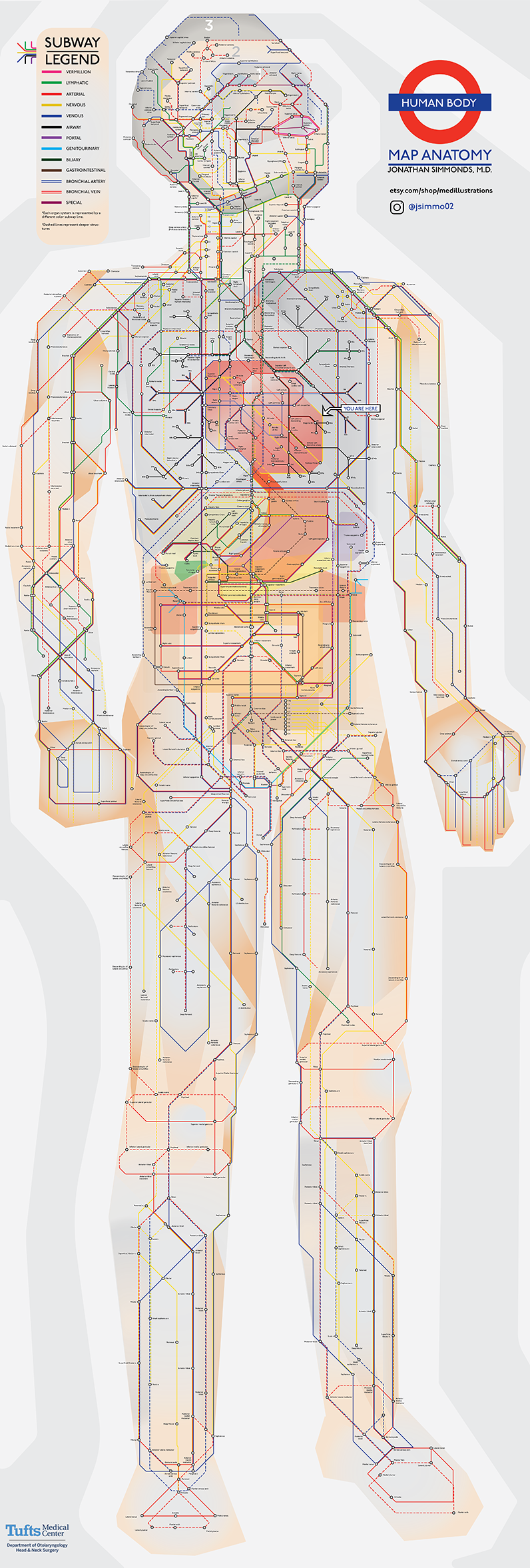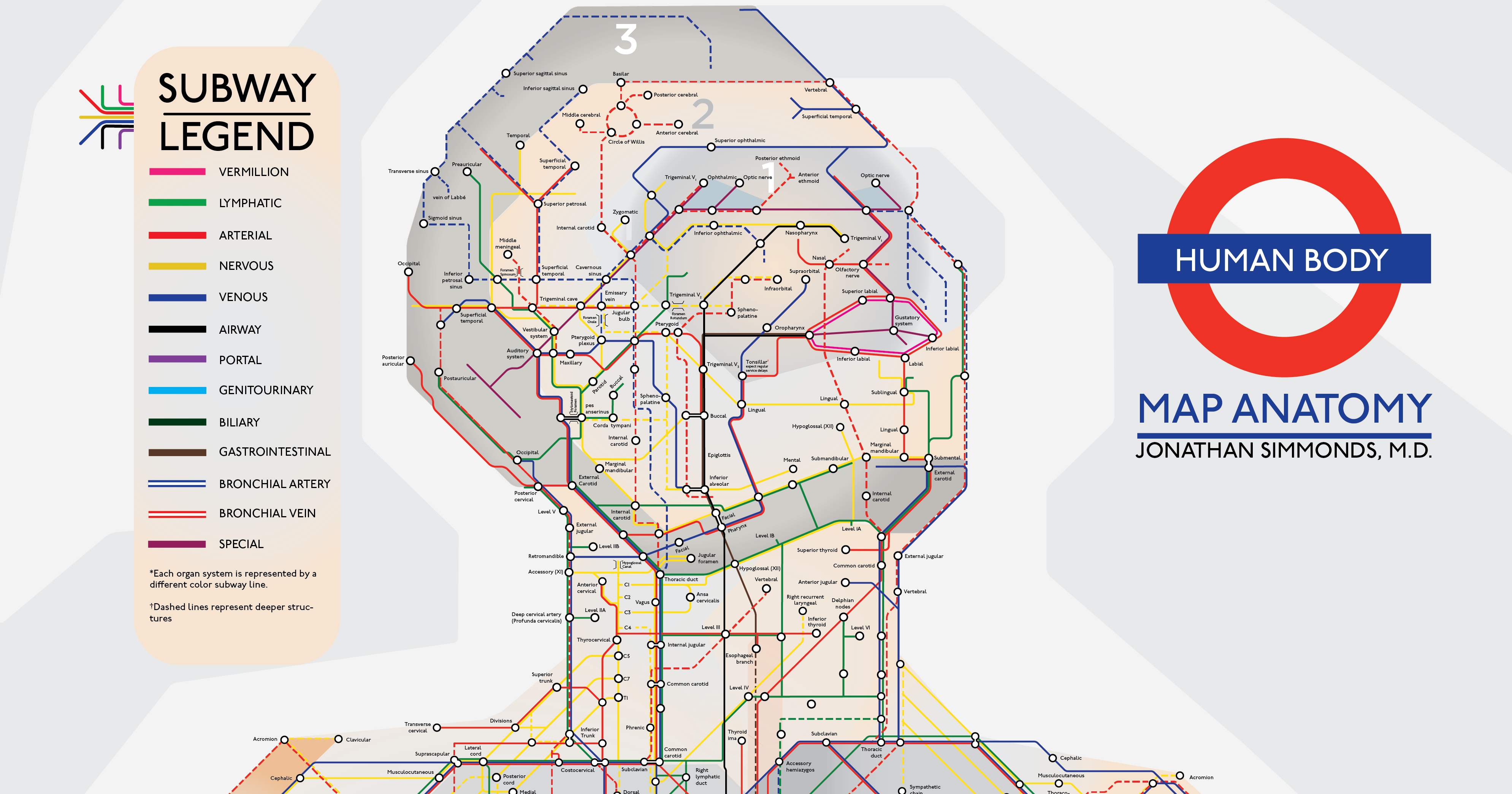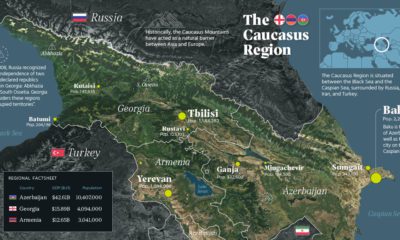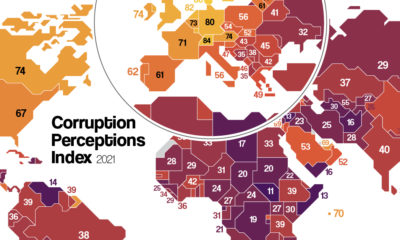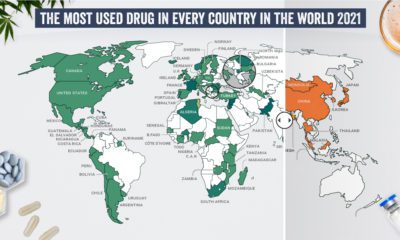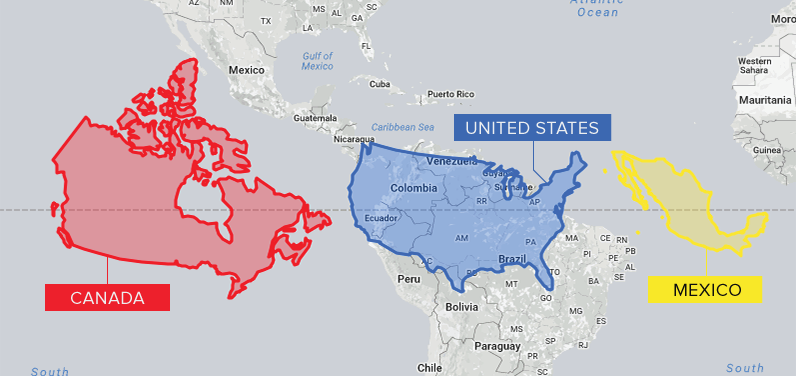Most people might imagine an intricate network of blood vessels or the complex neural circuits of the brain. Or we might picture diagrams from the iconic medical textbook, Gray’s Anatomy. Today’s visualization puts a unique spin on all of these ideas – interpreting human anatomy in the style of London’s transit system. Created by Jonathan Simmonds M.D., a resident physician at Tufts Medical Center, it’s a simple yet beautifully intuitive demonstration of how efficiently our bodies work. View a high resolution version of this graphic. Make sure to view the full resolution version of this intricate visualization.
From Point A to Point Z
Right away, we can see that each system is broken down into a few major colored ‘lines’. Here are a few:
Vermillion system (Pink line) This covers one of the smallest surface areas, namely the boundary around the mouth from the cupid’s bow to the bottom lip. Airway system (Black line) This represents the sections from the nose and mouth, down the windpipe and into the lungs. The system also works with bronchial arteries and veins – the striped blue and red lines respectively. Nervous system (Yellow line) This starts from the temporal lobe of the brain, and reaches all the way to the body’s extremities, such as the fingertips and feet. Portal system (Purple line) Approximately 75% of blood flowing from the liver passes through portal veins, which are one of two sets of veins connected to the liver. Special system (Magenta line) This includes organs responsible for four of the five traditional senses – sight, hearing, smell, and taste – as well the reproductive organs.
While dashed lines represent deeper structures, sections with ‘transfers’ show where different organ systems intersect. The head is also helpfully categorized into three ‘zones’. Of course, it’s not as straightforward as starting in one place and ending up on the opposite end – as with city transit systems, there are multiple routes that can be taken. If you’re still daunted by where to start with this map of human anatomy, there’s a helpful “You Are Here” at the heart. To counter common biases in the medical field, Dr. Simmonds has noted that he will soon update the illustration to include racialized and female versions.
An Enduring Symbol
From a broader design perspective, this anatomical subway map draws inspiration from the famous London Underground design. When engineering draftsman Harry Beck debuted this map back in the 1930s, it caused quite a stir. Many argued that it wasn’t geographically accurate, and that its scale was wildly skewed. But that didn’t matter to most commuters. Beck’s map offered something that no one else did – it combined all the different lines into one pocket-sized diagram. – Sam Mullins, London Transport Museum Director As a result, the Tube’s linear, color-coded aesthetic is arguably the most recognizable transit map in the world today. Many major cities hopped on board with the timeless new look, such as Sydney and Paris. This iconic subway map design has been used as a visual reference for everything from Ancient Roman roads to the Milky Way. That’s what makes it such a good application for the most complex network of all – the human body.
on Even while political regimes across these countries have changed over time, they’ve largely followed a few different types of governance. Today, every country can ultimately be classified into just nine broad forms of government systems. This map by Truman Du uses information from Wikipedia to map the government systems that rule the world today.
Countries By Type of Government
It’s important to note that this map charts government systems according to each country’s legal framework. Many countries have constitutions stating their de jure or legally recognized system of government, but their de facto or realized form of governance may be quite different. Here is a list of the stated government system of UN member states and observers as of January 2023: Let’s take a closer look at some of these systems.
Monarchies
Brought back into the spotlight after the death of Queen Elizabeth II of England in September 2022, this form of government has a single ruler. They carry titles from king and queen to sultan or emperor, and their government systems can be further divided into three modern types: constitutional, semi-constitutional, and absolute. A constitutional monarchy sees the monarch act as head of state within the parameters of a constitution, giving them little to no real power. For example, King Charles III is the head of 15 Commonwealth nations including Canada and Australia. However, each has their own head of government. On the other hand, a semi-constitutional monarchy lets the monarch or ruling royal family retain substantial political powers, as is the case in Jordan and Morocco. However, their monarchs still rule the country according to a democratic constitution and in concert with other institutions. Finally, an absolute monarchy is most like the monarchies of old, where the ruler has full power over governance, with modern examples including Saudi Arabia and Vatican City.
Republics
Unlike monarchies, the people hold the power in a republic government system, directly electing representatives to form government. Again, there are multiple types of modern republic governments: presidential, semi-presidential, and parliamentary. The presidential republic could be considered a direct progression from monarchies. This system has a strong and independent chief executive with extensive powers when it comes to domestic affairs and foreign policy. An example of this is the United States, where the President is both the head of state and the head of government. In a semi-presidential republic, the president is the head of state and has some executive powers that are independent of the legislature. However, the prime minister (or chancellor or equivalent title) is the head of government, responsible to the legislature along with the cabinet. Russia is a classic example of this type of government. The last type of republic system is parliamentary. In this system, the president is a figurehead, while the head of government holds real power and is validated by and accountable to the parliament. This type of system can be seen in Germany, Italy, and India and is akin to constitutional monarchies. It’s also important to point out that some parliamentary republic systems operate slightly differently. For example in South Africa, the president is both the head of state and government, but is elected directly by the legislature. This leaves them (and their ministries) potentially subject to parliamentary confidence.
One-Party State
Many of the systems above involve multiple political parties vying to rule and govern their respective countries. In a one-party state, also called a single-party state or single-party system, only one political party has the right to form government. All other political parties are either outlawed or only allowed limited participation in elections. In this system, a country’s head of state and head of government can be executive or ceremonial but political power is constitutionally linked to a single political movement. China is the most well-known example of this government system, with the General Secretary of the Communist Party of China ruling as the de facto leader since 1989.
Provisional
The final form of government is a provisional government formed as an interim or transitional government. In this system, an emergency governmental body is created to manage political transitions after the collapse of a government, or when a new state is formed. Often these evolve into fully constitutionalized systems, but sometimes they hold power for longer than expected. Some examples of countries that are considered provisional include Libya, Burkina Faso, and Chad.
